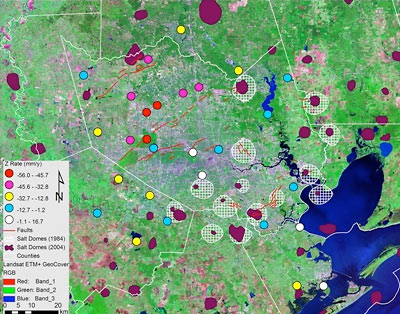
Parts of Jersey Village have been subsiding by about 2 inches a year, according to 2 UH professors and a former grad student who’ve been studying a decade’s worth of GPS data from 2 dozen area measurement points. Associate professor of geology Shuhab Khan, geology professor Kevin Burke, and former Ph.D. student Richard Engelkemeir note there’s been gradual subsidence in a “sprawling” 324-square-mile area of northwestern Harris County, but Jersey Village is the fastest to fall.
Just what is it that makes this little community so down-to-earth? Reports Khan:
The most likely reason for the sinking of Jersey Village is the withdrawal of water from deep beneath the surface. While groundwater withdrawal has ceased in most of the Houston area, it continues in the northwestern part of the county that has seen a rapid growth in population.
Continued subsidence, of course, will also help the entire northwest Houston area collect more water when it rains. But it isn’t all downhill for Houston.
***
The data also show an area along the coast southeast of Houston has actually been rising over the same period. The likely culprit there: salt domes under the surface. Khan says he hopes further research will connect salt-dome movement along the coast to surface movements in other areas of the region. Two years ago Khan, Burke, and Engelkemeir published a map identifying the precise locations of approximately 300 faults in the Houston area.





Being a resident and REALTOR in the NW part of Harris County, it sure would have been nice for Mr. Khan to release a map with the 324 square mile region highlighted.
I highlighted a 9-mile radius around Jersey Village on my blog to get an idea of the area. This is about equivalent to 255 square miles. Big area.
The Northwest area will be taken off groundwater soon. The ground to surface water conversions have been running full steam for the past several years. North and northwest Harris County areas are the first places this is occurring.
No wonder general flooding in JV is so bad. A strong rain storm comes through and streets immediately flood up over the curb! Its at your own risk to park anything lower than a jacked-up truck in the street on a cloudy day.
The cracks in our walls we continuously paint over and the pond that forms in our backyard after a couple of inches of rain can vouch for this. We’ve had our slab checked twice in the past year, and it’s *only* about an inch and 3/4 lower in one corner.
We can learn from other parts of the country that have more extreme water problems (Kalifornia comes to mind).
In other states (CA, WA), private water rights have been very systematically curtailed. Not saying that’s the answer (!), but it’s good to learn from these states.
It is interesting that the NW part of Harris County is the only part with this issue. I would assume the entire region gets similar amounts of rainfall and ground water usage.
Does Mr. Khan have a theory on why this part of the city is sinking?
RW,
This already is occurring throughout central Texas where water is much rarer commodity than in Houston. The component to any new development in central Texas that needs the longest leed time is access to potable water. Areas south of San Antonio all the way to DFW and points west have severe restrictions on water access. Recent rains have helped to resupply many lakes and aquifers, but that doesn’t last forever. Rural areas that aren’t likely to become urbanized are selling chunks of their available ground water and transporting them through pipelines to the northern Austin area. More agreements are being worked out.
Houston doesn’t have this problem. With the City of Houston expanding water sources to the Trinity River years ago relieving Lake Houston and Lake Conroe, much of the suburban development in the area that utilized ground water can be transitioned to surface water. Several water authorities have been formed and tasked with ground to surface water conversions with much progress being made with few knowing it’s even happening. Removing our use of ground water in our softer soil regions will remove the human component to subsidence. Natural geologic faults (yes, we have lots of them and they do move!) and neighboring salt dome activity will be left to disturb our ground (which are all out of our control).
So, which areas are rising? Is it only the areas underneath the salt domes? And why are the salt domes rising?
For the salt domes, you’ll need a real geologist to explain that. If anybody’s ever visited Avery Island, LA where Tabasco sauce is made, you were on a salt dome. The Island is just land that is substantially higher than the surrounding delta. Below is what I pulled from Wikipedia.
“Since the density of salt is generally less than that of surrounding material, it has a tendency to move upward toward the surface, forming large bulbous domes, diapirs, sheets, pillars and other structures as it rises. If the rising salt diapir breaches the surface, it can become a flowing salt glacier. In cross section, these large domes may be anywhere from 1 to 10 kilometers across and extend as far down as 6.5 kilometers.”
I know mined salt domes are often used for oil storage in Texas and Louisiana.
Which entity has the authority to FORCE transition to surface water in this giant area, given that has been obvious that previous area groundwater dependence has caused terrible subsidence problems, e.g., Houston proper?
Let me guess: A dozen little fiefdoms?
Madness.
If not (or if so), get on the damn stick and STOP IT. We all pay for the consequences of unplanned, developer-dominated growth. Example #500.
Houston-Galveston Subsidence District
http://www.hgsubsidence.org/
Fort Bend County has one also.
Water Authorities:
North Harris County Regional Water Authority
http://www.nhcrwa.com
West Harris County Regional Water Authority
http://www.whcrwa.com
Woodlands Joint Powers Agency
http://www.wjpa.net/
San Jacinto River Authority
http://www.sjra.net/
North Channel Water Authority
(no website I could find)
Central Harris County Regional Water Authority
(no website I could find)
So…over geologic time, salt domes are buoyant in soil that is essentially a liquid.
Thanks, kjb….(sincerely)
Looks like gridlock.
No prob, some co-workers of mine worked with the North Channel and the North Harris County Regional Water Authority in planning their water lines and developing some of the construction plans.
The main thing these authorities do is coordinate between all the layers of existing agencies and districts. They are essentially in the business of building large diameter water lines from Lake Houston to supply all the little Municipal Utility Districts. Navigating around existing roads, bayous, homes, etc. is a nightmare and if left up to the local government agencies would never get done.